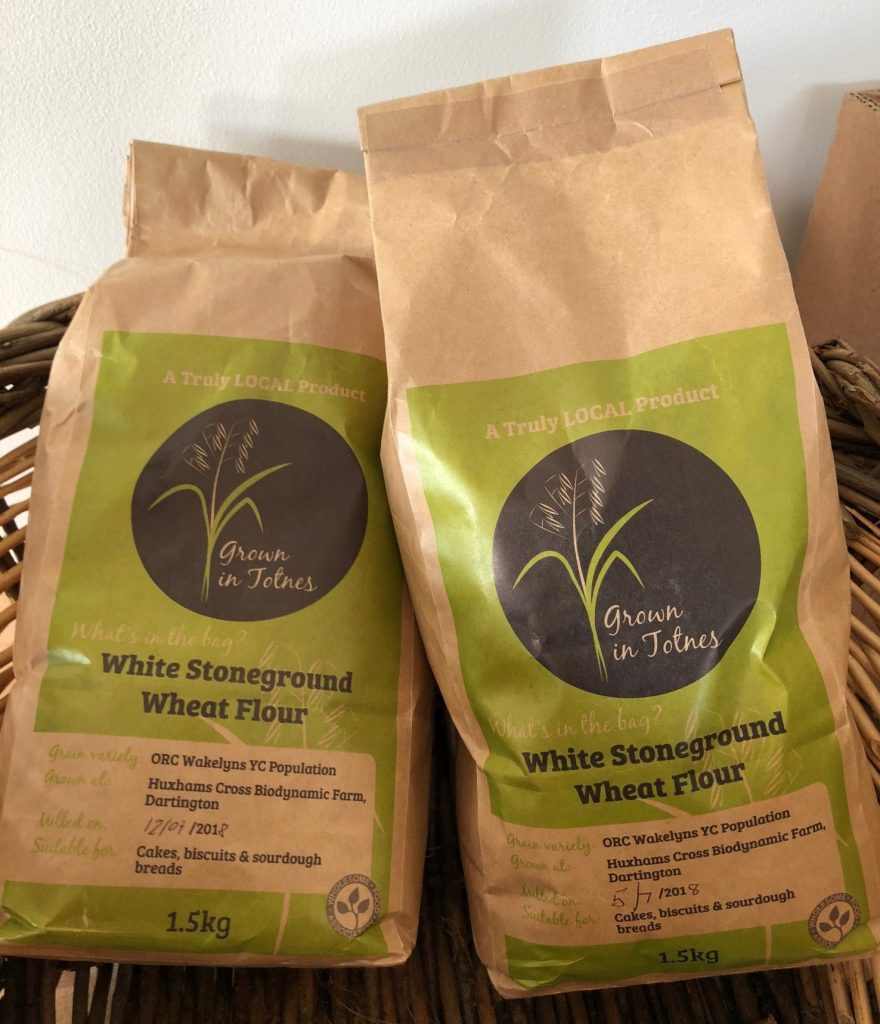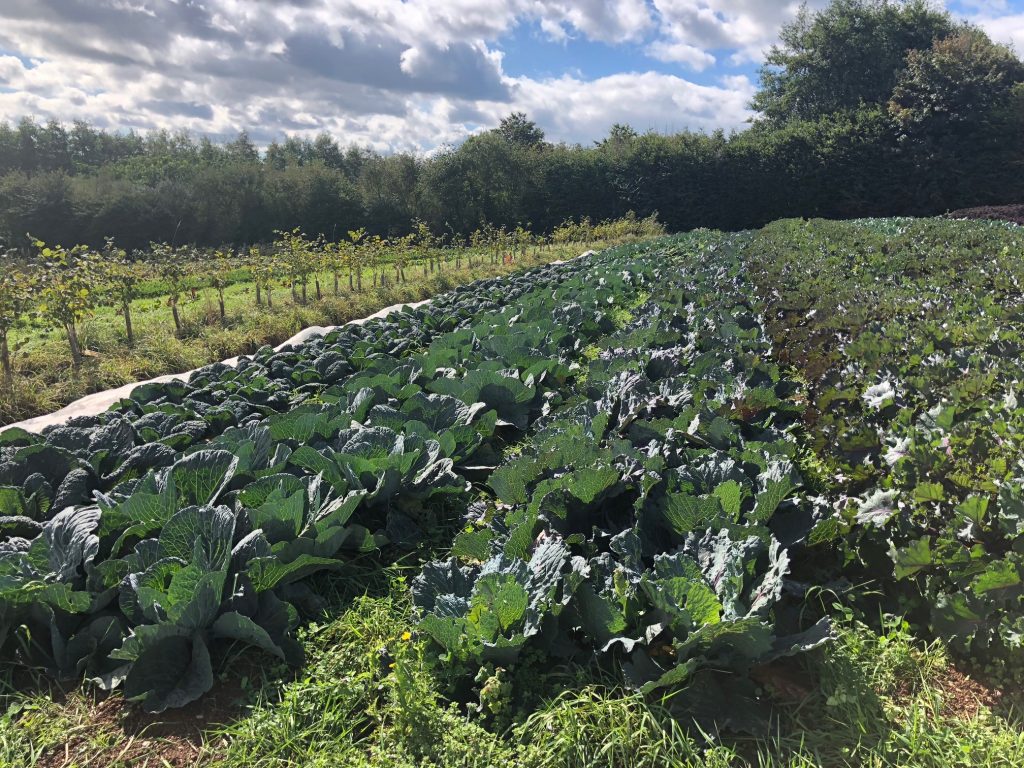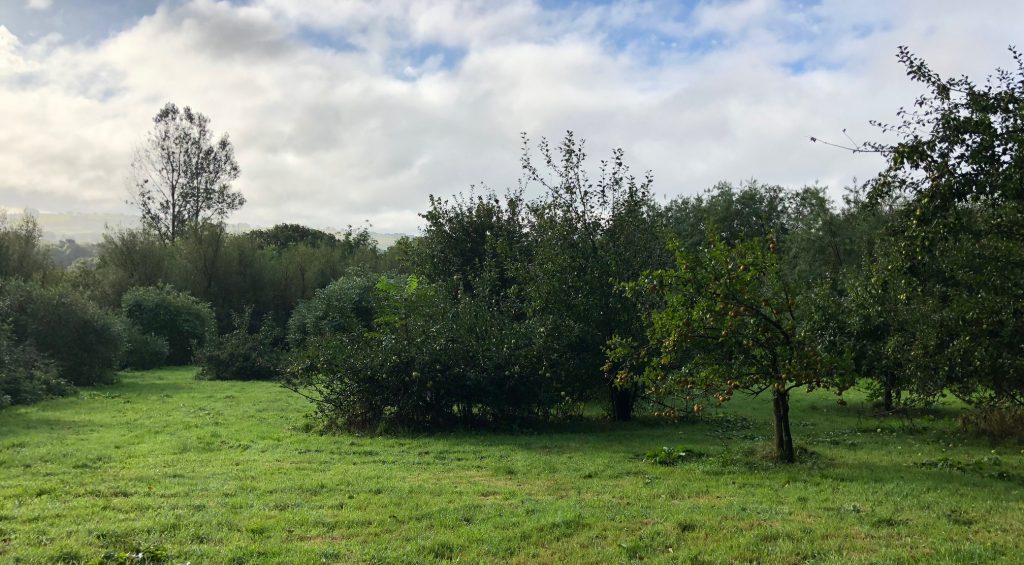Futures Forum: The Agroforestry Research Trust @ Dartington
Writer on sustainability issues Samuel Smith looks at the latest - including from Dartington:
AGROFORESTRY: WHERE TREES, FARMING AND BIODIVERSITY GET TOGETHER
OCTOBER 10, 2018 / BLOG
This summer I’ve taken the opportunity to learn more about agroforestry. In August I spent a day at Wakelyns Agroforestry Farm in Suffolk with the UK Agroforestry Network, hearing from a variety of UK projects. Then in September, an agroforestry weekend course with Professor Martin Wolfe, hosted by Huxhams Cross Farm in Dartington.
Over the years I’ve become increasingly convinced of the important role agroforestry can play in helping our farming systems become more resilient to environmental pressures such as climate change. Therefore it’s been a pleasure to visit these sites, hearing first-hand the experiences from agroforestry experts. In this piece, I’m sharing some of the insights and learnings that stuck with me, as well as some resources.
First off, what is agroforestry? It’s the deliberate integration of trees and shrubs into crop or pastureland. This may be done for a variety of reasons. For example, providing shelterbelts for crops, valuable shade for animals, habitats to increase biodiversity, improvements to soil structure and health, and crop diversification. As such, agroforestry is not new. Humans have always been dependent on, or closely associated, with trees. Agroforestry practices stretch back thousands of years. You could even say that we evolved as agroforesters.
While many farmers are conscious of the value trees bring to their landscapes, industrial farming systems have created ever-increasing field-sizes, devoid of trees and shrubs, and dominated by single-variety mono-cultures. To provide reliable, predictable and cheap outputs, these systems are co-dependent on chemical inputs and large, expensive machinery. The result is cheap food. But at what cost?

Vast monocultures dominate many farming landscapes
The UK Environment Secretary, Michael Gove recently said that our soils have 30-40 harvests left. A fundamental destruction of soil fertility is underway. Alongside this, we’re witnessing other escalating environmental pressures such as climate change and an unprecedented loss of biodiversity, while being tasked with a quest for sustainable intensification as available land declines. So naturally, there’s increasing attention towards regenerative agricultural practices (methods of farming that increase ecosystem services, rather than deplete them) and in particular, agroforestry.
Professor Martin Wolfe and Wakelyns
It’s fitting to begin by introducing Professor Martin Wolfe, a pioneer of agroforestry in the UK. A plant pathologist by trade, Martin spent his early career as a scientist, particularly interested in the co-evolution of pests and wheat diseases. In 1984, while working at the Plant Breeding Institute in Cambridge, Martin was introduced to the term “agroforestry”. This was a key moment that started to shape his ideas and research. The idea of integrating the diversity of annual and perennial crops into a farm system led Martin and his wife Anne, to establish Wakelyns, a 22.5 hectare organic agroforestry system in 1994. The aim was to understand and compare different types of agroforestry systems. In particular, Martin has been fascinated with the diversity at every level of farming, from the soil microbia, to crop varieties and populations and the species of flora and fauna across the farm.

Professor Martin Wolfe, with Marina O’Connell at Huxhams Cross Farm
In agroforestry, there are some broad categories of systems:
> riparian buffers: trees lining the edges of a watercourse: offering shade protection, as well as slowing down and filtering the water entering into the watercourse.
> shelterbelts: usually wind protection. One of the largest examples of a shelterbelt is the Great Green Wall in China – still being planted, it is designed to protect from the dust storms of the Gobi Desert. It’s estimated to be completed in 2050, at which point it will be 2,800 miles long!
> wood pasture: a mosaic habitat of trees, such as can be found in national parks.
> silvopasture: combining trees and the grazing of animals in a mutually beneficial way.
> parkland: such as you might find on estates.
> forest gardens: designed to emulate natural woodland, very intensive, multi-layered planting of crops, typically small-scale.
> alley cropping: described below:
At Wakelyns, the dominant approach is alley cropping whereby rows of trees are planted and a crop is grown in the alleyways between these rows. There is quite a different feel to a farm landscape that uses alley-cropping. It’s not possible to gaze across an expansive landscape. Instead, the feel is of intimacy. Secluded, quiet lanes that buzz with wildlife. The alley cropping system at Wakelyns, I understand, is the most mature in the UK.
The alleys at Wakelyns are orientated North-South, this is typical for minimizing shading in the crop lanes. Martin’s alleys are 12m width, which he selected to support a range of farm machinery (divisible by 3 or 4m). The tree rows are 3m wide. The site features three sets of tree system: a) hardwoods (e.g. ash, hornbeam, oak, hornbean), b) a hazel and willow coppiced system c) fruit and nut system.
The hazel is planted as a double hedge and coppiced alternately every five years, previously for weaving and thatch roofs and currently for on-site heating fuel. This rate of growth is considered fast – a standard coppice cycle is typically every seven years.
The willow is a five-component mixture of species, also planted as pairs, with 75cm between rows and 90cm spacing.

Land Equivalent Value (LER)
Some farmers may fear that trees compete for valuable space and water on a farm – thereby decreasing the yield of the primary crop. This is where the Land Equivalent Ratio (LER) becomes an important concept to help compare the yields of an agroforestry system that have multiple outputs (e.g. the yield from the tree crops such as fruit or timber) against a monoculture system.
The LER indicates the area of monocultures needed to produce as much as one intercropped hectare. Anything above one is a gain. So for example, if the LER is 1.4, the agroforestry system yields 40% more than if the crops are grown separately on two plots. How might this happen? There can be multiple reasons that support a positive interaction between trees and crops. For example, increased crop shelter (the trees help reduce wind speeds), improved soil and water quality protection, and reduced evaporation and water loss from crops. At Wakelyns, Martin has calculated an LER of 1.4 but he is mindful to note that there is nothing to accurately compare this against, as he doesn’t have a nearby monoculture of the same crop varieties grown under the same conditions. Martin believes that LER is helpful but we also need to develop Biodiversity, Carbon and Water Equivalent Ratios, helping understand better the other benefits happening in an agroforestry system. To this end, there is huge potential for further research.

Graphic from from Briggs, S. (2015). A farmers perspective on Agroforestry (presentation).
Population Wheat
One aspect of the visit that was particularly interesting was Martin’s work on Composite Cross Populations of wheat. Starting in 2001/02 and in partnership with the Organic Research Centre, an evolutionary breeding programme has produced a hugely diverse population of wheat suitable for organic and low-input farming systems. Known as “Population Wheat”, it was bred by making 190 crosses among 20 different parent varieties (some high yielding, and some highly resilient) and mixing all the resulting seed. This has now been through eleven generations of natural field selection, including at Wakelyns.
The diversity in the “populations” approach, both genetic and physical, means the crop has a better capacity to cope with a more variable climate, pests and diseases. This means that it’s also better suited for organic, low-input approaches. In a conventional monocultural system, identical varieties of the same crop are typically planted across a field. While this approach has convenience for marketing and manufacturers, the crop is less adaptable to environmental stresses. The Population Wheat demonstrates Martin’s pursuit for species diversity, not just at a macro-scale through alley-cropping, but within arable crop species.

A local food system
While many arable farmers have little control or knowledge of where their crop ends up, Martin has been able to link his farm products into a traceable local food system. This includes supplying into the award-winning Hodmedod’s – that specialise in beans and pulses from British farms (particularly focusing on less well-known and neglected crops) and Kimberley Bell’s Small Food Bakery in Nottingham. Both these enterprises have won BBC’s Food and Farming Awards in recent years. Establishing such a local food system is something Martin is passionate about and it demonstrates a replicable model for others.
Truly Traceable are also known to visit Martin’s farm – a rather unique enterprise that produces venison and game pies. Customers receive a certificate with their order, providing the location and a photo of the animal shortly after it’s been shot!
Huxham’s Cross Farm
The agroforestry course with Martin Wolfe took place at The Apricot Centre, Huxhams Cross Farm in Dartington. This is a 34 acre biodynamic, mixed farm that provides therapeutic support for families and children, as well as food production that includes the Population Wheat mentioned above, and mixed fruits, vegetables, and eggs, available through a local box scheme and markets.
This was my second visit to Huxham’s Cross this year and I’m incredibly impressed with how quickly this enterprise is transforming the land into a thriving, diverse and productive farm. It was only acquired in 2015 by the Biodynamic Land Trust and previously had been conventional barley for the last 40 years. An inspiring sign of how quickly landscapes and soils can start to be transformed. Not to mention, how farms can be designed as valuable places for people.
In terms of their application of agroforestry, vegetables are growing in an alley cropping system, with rows of hazel planted at 28m spacings. The hazel provides wind shelter, functional biodiversity and slows down the movement of water (and topsoil) down the field which slopes towards a brook. There’s a little more about the design process for the farm here, which was inspired by permaculture principles.

Broadlear’s Agroforestry Project
Just down the road is another new agroforestry project which Huxham’s Cross Farm is also involved with. What’s unique about this 48-acre field is the collaboration between multiple people and organisations: considered a “UK first” and therefore a valuable model to learn from. The different Parties include:
> The landowners – Dartington Hall Trust
> The farm tenant (Jon and Lynne Perkin, Dartington Dairy) – who are growing forage crops in the alleys for their goat herd.
Agroforestry tree license holders including:
> Huxham’s Cross Farm – who have planted 600 fruit trees on 20m spacing
> Salthouse & Peppermongers – who are growing the UK’s first ever commercial table crop of Sichuan pepper.
> Luscombe Drinks – who have planted elderflower for their drinks.
There are some excellent, detailed blogs written by Harriet Bell that cover the design of this project, so I won’t even attempt to go into any detail here.

Agroforestry design at Broadlears

Broadlears Agroforestry site
I’ve had the pleasure of visiting Martin Crawford’s two-acre Forest Garden several times over the years and went on a course with him in 2014 (some notes of which are here). Martin Crawford is one of the most recognised practitioners of forest gardening and has written some excellent reference guides to support others.
In terms of agroforestry approaches, forest gardening is the most intensive and diverse, often showcasing an enormous diversity of species. Because of this, forest gardens are typically more suited to smaller scale systems and are unlikely to be commercial operations. Martin’s two-acre forest garden was planted in 1994, interestingly, the same time Martin Wolfe was planting his trees at Wakelyns. As such, it’s a fantastic example of a mature forest garden. Each time I visit it’s like being in a wonderland of edible curiosities. Inspiring, peaceful and a place from which there is a lot to learn.
Martin also has two other sites where agroforestry is demonstrated at a different scale. An 11-acre site nearby in Littlehempston and a Fruit and Nut forest. On this occasion, we were also able to visit his Fruit and Nut forest, which is more of a commercial enterprise. Compared to his 2-acre site, the trees here are given wider spacings, allowing them to spread out and enabling much better access for harvesting. The way trees are planted is more like a parkland, but very well sheltered by strips of willow and hazel.

Martin Crawford's Fruit and Nut Forest
How might we scale agroforestry?
Agroforestry is becoming more recognised and growing in popularity. As the urgency of climate change intensifies and increasing calls for carbon drawdown unfold, there will be an increasing number of voices that call us to plant more trees, transform our landscapes and our agriculture systems. This is right. However, as it stands, integrating agroforestry into food production systems, as seen in alley cropping, remains a niche, counter-cultural idea. For many farmers, I suspect it feels a risky, uncertain and long-term investment. It’s easy to understand why. In the UK there aren’t enough examples of mature, productive farms thriving from their investment into agroforestry. For many conventional farmers, exploring agroforestry will require a shift in thinking about their approach to food production; moving from mono-cropping systems to a more complex, diverse system, besides an investment into new or different machinery.
When thinking about how agroforestry can scale, we need to take a hard look at the existing lock-ins of our industrial agricultural systems. IPES-FOOD’s Uniformity to Diversityreport did a fantastic job at identifying these. For example, conventional farmers who have invested in large-scale, expensive machinery that lock them into industrial-scale cropping systems. Other lock-in examples might include farm business tenancies that don’t lend themselves to a patient, long-term investment into alley-cropping systems; or a policy environment that doesn’t support or understand farming agroforestry systems.
I like to think that all these challenges are surmountable. We urgently need many more agroforestry demonstration sites, knowledge sharing and support for farmers to test it. We should look globally at examples of best practice of where agroforestry is working in other countries. Examining the policies that will support it and the innovative ways in which farmers might integrate it – such as the multi-tiered tenancy approach at Broadlears. Right now in the UK, there’s a big opportunity with the new Agricultural Bill, to put in place measures to support agroforestry.
Agroforestry won’t happen automatically in response to environmental pressures. It needs advocating. Fortunately, we have some fantastic organisations promoting it (see the resources below) that need more support. Furthermore, we need to support the farming pioneers who are already practicing agroforestry. They have so much to teach us.
Useful resources
AFINET has been set up to share good practice, latest news and scientific achievements.
World Agroforestry Centre: based in Nairobi, a centre acts as a repository of agroforestry science and information, developing knowledge practices to ensure food security and environmental sustainability.
AGFORWARD: an EU four-year research project into agroforestry.
Agroforestry Research Trust: non-profit set up by Martin Crawford to research temperate agroforestry and all aspects of plant cropping and uses, with a focus on tree, shrub and perennial crops.
The Woodland Trust – UK charity, that can provide advisory support and free trees for farmers
2018 article in the Guardian on agroforestry: The latest cutting-edge technology changing our landscapes? Trees
Stephen Briggs’: a key practitioner and advocate of agroforestry in the UK. His system is based on 24m alleys, with a mix of perennials (apple trees) and annuals (cereals). He also runs Abacus Agriculture can provide advice on design.
Jonathan Smith, from Scilly Organics and the Farm Carbon Cutting Toolkit also wrote up his visit from the day at Wakelyns here.
More information on Composite Cross Populations from the Organic Research Centre
Agroforestry: where trees, farming and biodiversity get together – Samuel Smith
See also:
Futures Forum: The Water, Energy and Food Nexus
Futures Forum: Gender and the environment @ Radio 4's Costing the Earth
.
.
.

No comments:
Post a Comment